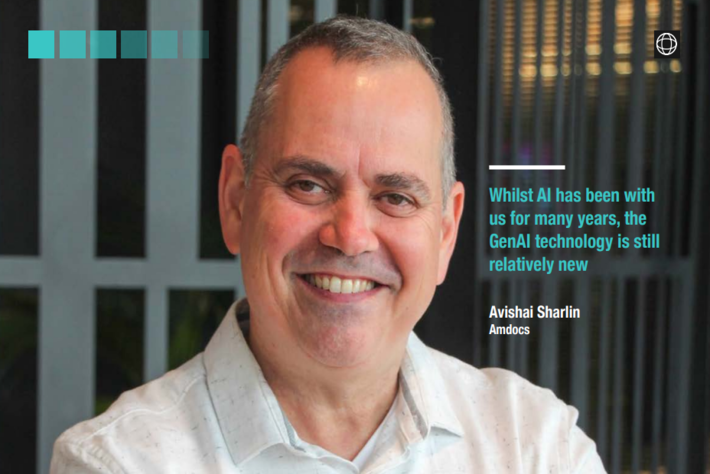Generative artificial intelligence (GenAI) has enjoyed huge market profile thanks to attention grabbing examples enabled by open source tools such as ChatGPT. The real value comes with the application of GenAI capabilities to specific verticals by frameworks that understand industry taxonomy and integrate with a robust, secure and scalable infrastructure ecosystem that, for communications service providers (CSPs), is telco-grade in terms of accuracy and scale.To enable this, Amdocs introduced its amAIz GenAI platform last year. amAIz combines a carrier-grade architecture that utilises open source technology with large language AI models to create a foundation for CSPs to adopt or develop GenAI-powered applications or use cases across their businesses from customer engagement to network operations. Avishai Sharlin, the division president for Products & Network at Amdocs, tells George Malim, the managing editor of VanillaPlus, how the platform has created an ecosystem that brings together telecoms-specific taxonomy with hyperscale capabilities so CSPs can save costs, streamline operations and accelerate their paths to effective GenAI adoption.
George Malim: Artificial intelligence has been established for many years and generative AI is already gaining traction. How do you see adoption of GenAI and what excites you the most?
Avishai Sharlin: Whilst AI has been with us for many years, the GenAI technology is still relatively new. Lately, announcements of offerings from providers like OpenAI and rapid evolution of the GenAI solutions have created a lot of interest in the market. All the webscalers are heavily involved in GenAI and if you combine it with new open source tools you will find many technologies out there. And yet, success will be measured by actual adoption. Technology is finding its way into almost every aspect of our lives and I believe GenAI will follow the same path, hence having a big impact.
The actual size of that impact depends on many aspects, clearly like with every other technology, once it hits reality there are needs that should be addressed. For example, security, scalability and reliability. I think the market looks at GenAI as a technology with great promise and expects a lot from it
GM: What does that mean for the telecoms industry? We have witnessed similar levels of excitement around many other technologies in the past but only a few of them have proved to be right. Do you anticipate a similar destiny for GenAI?
AS: Telecoms is no different from any other segment in the market. Many of our customers see GenAI as a means to address areas that are important to them such as customer experience. GenAI, for sure, can contribute in those areas and provide a better approach for customers and for the organisation.
There are a variety of angles that GenAI can help with and it will assist the players to address several needs they are targeting for quite long period. This is the good news and it is encouraging people to explore GenAI. The technology is being delivered by the giants in the market which are supporting it at massive scale and are investing a lot of resources to develop it. That helps to grow confidence that this isn’t something that is going to disappear and that it will be with us for the long term.
GM: What are you seeing from your CSP customers in terms of their adoption of GenAI and their future plans?
AS: Our customers are at different levels of adoption. All are ‘playing’ with the technology but with different aims and different types of commitment. Some are taking it internally to aid efficiency and improve their own organisations and I think that’s no different in healthcare or manufacturing than it is in telecoms.
Others are also looking to provide better user experiences for their end customers and exploring how to engage them in a better way. The more advanced are already putting in place solutions that are targeting segments of customers and markets, and are tailoring GenAI solutions to be implemented. Those companies are taking the concept into a maturity level that feeds development and acceptance. If you’re the chief executive of a company and there is a technology out there that promises to lower total cost of ownership (TCO) or make life easier, the chief executive immediately wants to check the applicability for their own organisation. When they see that efficiency has improved by x or y, the concept gains traction. At the same time, the chief executive will want to explore how the technology can be utilised to provide better insights and allow the company to do things it was unable to do in the past, sell better or cater more effectively for specific segments and customers.
This provides another angle for the GenAI experience. One angle is to explore new business, another is to make the existing business more effective. In most organisations this would involve separate initiatives so adoption would be segmented into departments, such as network or marketing, however with GenAI it’s not a case of ‘or’, it’s a case of ‘and’.
GM: How are CSPs translating early GenAI use cases into their businesses? Do you see it being used to enable capabilities such as network automation?
AS: There’s not a specific use case that GenAI was built for, it fits marketing, the network, applications such as customer care and many other areas. It is therefore not limited to a specific domain. Having said that, there areas we see as more relevant than others, for example in relation to networks and automation. Another focus area is the customer care domain. It is being looked at by the industry to see how GenAI can address the experience and enable CSPs to offer something better. Other domains will come right after this.
CSPs in general know this technology can be embedded in many aspects of their day-to-day operations, this includes how they initiate and instantiate new networks or how they address automaton of their DevOps infrastructure. All of these areas and more are being addressed.

GM: You’ve introduced your amAIz offering. Why has Amdocs developed this and how can it help customers?
AS: When we explored GenAI we immediately understood that everyone is a player so we looked at our capabilities to determine what’s unique and how we can differentiate ourselves. Our experience is across all telco domains: BSS, OSS and network. This, combined with our ability to support the industry’s scalability and security requirements are essential.
Deep understanding of domain-specific context is vital. In telecoms, for example, we need to cater for what we call the telco taxonomy. This means industry-specific terms need to be understood correctly by GenAI. For example, 5G could be taken to mean King George V rather than fifth generation mobile. You then get into other complexities that could be company specific. For example, what does PO mean? For the majority of the company it might be purchase order but for another department, it’s product offering.
Eventually, the GenAI function will be able to understand and be more accurate as opposed to being constrained to a generic model. It will become more efficient and precise and this led us to develop our offering and solution. Accuracy and context will dramatically impact the cost of GenAI. Cost has a lot to do with the success of projects because you could have a use case that costs US$10 million to operate but only saves US$1m.
When considering the next level of GenAI maturity beyond early trial use cases, several angles are game changers. Security is one, scale is another. To make GenAI a reality, you need a holistic approach that will allow you to address the specific needs of an industry with the right application or use case. We created the amAIz platform focusing on assisting our customers to utilise GenAI capabilities at scale.
GM: How will customers use amAIz?
AS: All the elements I’ve just discussed are embedded into amAIz but importantly it also addresses the use cases and how to create them. The platform we have developed allows customers to create use cases in a simple, drag and drop, low code/no code environment. This holistic approach targets all the shapes and forms of how you will embed GenAI in the organisation and it is already being adopted by some of our largest customers across different use cases and we’re very happy with the results we’re seeing so far.
We have initiated strategic partnerships with Microsoft, with NVIDIA as the leading chipset provider, and Amazon Web Services. We understand the need to be open and agnostic with technology so if we come with amAIz and we can fit ourselves to our customers’ environments.
There are two additional benefits that we bring. The first is that all our products come with use cases built-in. Our new catalogue system, for example, comes with co-pilot support and so businesspeople can add new offerings based on insights or create new packages in a very simple way. The second is our ability to understand and control the cost efficiency of the overall solution.
With amAIz, not only will you be able to utilise GenAI faster, you will also be able to operate efficiently. In a typical GenAI use case there are a chain of events in an ecosystem and there are many questions that can be asked. You can query different tools with very different costs and levels of response accuracy. amAIz can assist you whether to query x or y model and can help to deliver the same result but at a lower cost. That’s because our system understands the telco taxonomy and is optimised to be more accurate.
amAIz is a platform that allows users to do things faster while allowing access to the telco taxonomy. Its in-house technology is used to develop our own use cases. That means amAIz is embedded in our product offering, such as in CPQ Pro our new configure, price, quote offering that comes with embedded GenAI capabilities. The same will apply to our network suite and our billing suite and so on, all are coming with GenAI.
GM: What’s next for amAIz?
AS: GenAI will be at the centre of our booth at MWC 24 in Barcelona and we will showcase our products there that have embedded GenAI capabilities which are used to power end-to-end experiences. It’s going to be phenomenal. Seeing is believing and the proof will be there in the Microsoft booth, on the AWS booth and holistically in our booth.
GenAI has powerful possibilities to enable new capabilities and amAIz enables these to be executed in ways that are tailored for CSPs according to priorities, the nature of the transaction and the integration into other systems. Many interactions, tasks and queries need to be treated in this way rather than the traditional way in order to deliver better experiences, save cost or enable faster time-to-market (TTM).
I think the first use cases we will see will be in customer care domain shortly followed later on – and that’s quite soon – with use cases coming from the network. We’ll be demonstrating some of those at MWC relating to network automation and network slicing. GenAI is already in telecoms and proving its value and we’re really excited by the innovation we are bringing to the market.
Comment on this article below or via X: @VanillaPlus






